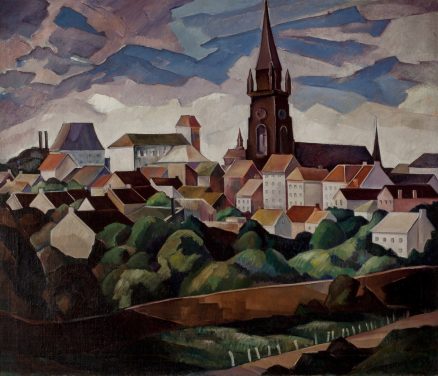Untitled (Landscape with Church Steeple)
, circa 1920sOil on canvas, 30 by 35⅛ inches
- Categories
- Immigrant artists
- Landscapes
- Zoom in on Artwork
- Print Page
- Email Page to Friend
Emile Grumieaux established a reputation with landscape and still-life images that were modernist without offending conventional sensibilities. Like other progressive Chicago artists of his generation, he emphasized a bold reduction of forms and patterned brushwork in compositions that remain grounded in the representation of familiar scenes. “The artist . . . has engaged himself chiefly with form and movement and with color only as far as values are concerned,” noted the Chicago Tribune’s critic Eleanor Jewett in 1930.i Probably dating to the 1920s, this work shows a townscape of closely packed houses behind which a dark-toned church rises, its steeple just contained within the composition. White walls, angled red roofs, and rounded trees massed in the foreground create a decorative geometry that contrasts with the dramatic cloudscape’s jagged patchwork of blues and grays, graduating to white on the horizon to set off the irregular urban skyline.
Grumieaux painted landscapes in many locales, from the Chicago steel mills to his native Belgium. Jewett described the artist as enjoying “pattern more than subject,” but in this case the subject had personal significance.ii The distinctive steeple seen here, with its four corner turrets and round clock faces above gothic windows, can be identified as that of the church of Saint-Jean-Baptiste in Grumieaux’s native Gosselies, Belgium (now part of the city of Charleroi). Raised in Chicago, Grumieaux had supplemented his early art training there with further study in Belgium, and he may have made return visits to Gosselies on subsequent trips to Europe. This composition evokes the artist’s nostalgia for a departed home. With its neat dwellings clustered cozily between verdant greenery and the protective looming form of the church, the idyllic village is appealing yet inaccessible, cut off from the viewer’s space and the empty road at lower right by an impenetrable wall.
Wendy Greenhouse, PhD
i Eleanor Jewett, “Tennessee Anderson’s Fine Sculpture Now Is on Show,” Chicago Tribune, Jan. 11, 1930.
ii Eleanor Jewett, “‘The Ten’ Show Is Delightful May Art Exhibit,” Chicago Tribune, May 31, 1936.
